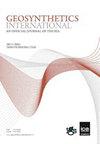Modeling geogrid-stabilized aggregate base courses considering local stiffness enhancement
IF 3.3
2区 工程技术
Q2 ENGINEERING, GEOLOGICAL
引用次数: 0
Abstract
Lateral restraint is the primary stabilization mechanism associated with the interlocking of aggregate particles in the geogrid apertures. This paper presents findings from a laboratory study which quantifies the local stiffness enhancement of aggregates through micromechanical interlocking provided by two different types of geogrids. These findings are applied to model the resilient response characteristics of geogrid-stabilized base course composite systems. Using three pairs of bender elements as shear wave transducers, horizontal stiffness profiles were determined above mid-heights of aggregate specimens. For two types of geogrids with square- and triangular-shaped apertures, the shear modulus profiles decreased moving away from the geogrid location. Based on a relationship for aggregates, resilient modulus was estimated from the shear modulus. Considering the variations in resilient moduli with distance from the geogrid location, the local stiffness enhancements provided by the two geogrid types were assigned to modulus profiles of a geogrid-stabilized aggregate base course in flexible pavement mechanistic analysis and modeling. The modeling results demonstrate the effect of geogrid base stabilization on the computed pavement resilient responses for both geogrid types. The sublayering approach which properly considers modeling of the geogrid influence zone could be effectively used in mechanistic analysis of a geogrid-stabilized pavement system.考虑局部刚度增强的土工格栅稳定骨料基层建模
横向约束是土工格栅孔中骨料颗粒联锁的主要稳定机制。本文提出了一项实验室研究的结果,该研究量化了两种不同类型土工格栅提供的微机械联锁对聚集体局部刚度增强的影响。这些发现被应用于模拟土工格栅稳定基层复合系统的弹性响应特性。采用三对弯曲单元作为剪切波传感器,确定了集料试件中高以上的水平刚度分布。对于具有正方形和三角形孔径的两种类型的土工格栅,剪切模量曲线在远离土工格栅位置时减小。基于骨料的关系,从剪切模量估计弹性模量。考虑到弹性模量随距离土工格栅位置的变化,在柔性路面力学分析与建模中,将两种土工格栅提供的局部刚度增强分配给土工格栅稳定骨料基层的模量剖面。模拟结果表明,两种土工格栅的基础稳定对计算的路面弹性响应有影响。适当考虑土工格栅影响区建模的分层方法可以有效地用于土工格栅稳定路面系统的力学分析。
本文章由计算机程序翻译,如有差异,请以英文原文为准。
求助全文
约1分钟内获得全文
求助全文
来源期刊

Geosynthetics International
ENGINEERING, GEOLOGICAL-GEOSCIENCES, MULTIDISCIPLINARY
CiteScore
6.90
自引率
20.00%
发文量
91
审稿时长
>12 weeks
期刊介绍:
An online only, rapid publication journal, Geosynthetics International – an official journal of the International Geosynthetics Society (IGS) – publishes the best information on current geosynthetics technology in research, design innovation, new materials and construction practice.
Topics covered
The whole of geosynthetic materials (including natural fibre products) such as research, behaviour, performance analysis, testing, design, construction methods, case histories and field experience. Geosynthetics International is received by all members of the IGS as part of their membership, and is published in e-only format six times a year.
 求助内容:
求助内容: 应助结果提醒方式:
应助结果提醒方式:


